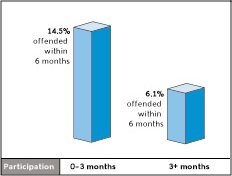This reserach brief of a study by Paul McCold, Ph.D., reports on the effect of restorative practices on reoffending, attitudes, and program completion among students at the CSF Buxmont schools in southeastern Pennsylvania. Dr. McCold presented this paper at the American Society of Criminology annual meeting, November 13-16, 2002, Chicago, Illinois.
From Evaluation of a Restorative Milieu: CSF Buxmont School/Day Treatment Programs 1999-2001, Evaluation Outcome Technical Report, Paul McCold, Ph.D., International Institute for Restorative Practices, 2002.
At the American Society of Criminology’s annual meeting in Chicago in November, 2002, Dr. Paul McCold, director of research for the International Institute for Restorative Practices (IIRP), presented the results of a two-year study of six school/day treatment programs operated by Community Service Foundation (CSF) and Buxmont Academy. The schools serve adjudicated delinquent and at-risk youth in southeastern Pennsylvania.
“I was a researcher at the New York State Division for Youth for ten years and never saw results so dramatic. None of the programs we evaluated demonstrated a reduction in reoffending," said McCold. His report presents outcome measures for 919 youth discharged between June 1999 and August 2001. The CSF Buxmont schools produced positive results in youth in three performance measures: offending rates following discharge, program completion rates and youth attitudes.
The evaluation protocol used in the IIRP’s research was developed by Temple University’s Crime and Justice Research Center. Dr. Philip W. Harris, associate director of the Center and associate professor at Temple University’s Department of Criminal Justice, observed, “We must applaud the Community Service Foundation for its efforts to measure and use program outcome data. It is unfortunate that so few programs for delinquent and at-risk youths can produce the kind of information about program quality that CSF has managed to assemble.”
1. LOWER OFFENDING RATES | |
 | • Offending during the six months following discharge was reduced by 58% for those youth who completed the program successfully with more than three months participation. • Even high-risk youth were less likely to offend following discharge, including those discharged unsuccessfully, if they participated in the program for more than three months. • The greatest reduction in offending occurred among youth with the highest risk factors for offending. |
2. HIGH PROGRAM COMPLETION RATES | |
 | • Nearly two-thirds (66%) of the youth who entered the CSF Buxmont schools completed the program successfully. • Those who were discharged prior to completing the program did not differ by age, gender, race, prior offending, or other risk factors. • Youth with the lowest social values and self-esteem scores upon entry stayed longer than others and showed the most improvement. |
3. POSITIVE CHANGES IN ATTITUDE | |
 | • Social values scores increased an average of 10% after six months of participation. • Self-esteem scores increased an average of 8% after six months of participation. • These improvements were independent of referral source, age, gender, race, prior offending, or other risk factors. • The overall trend toward more positive social values and higher self-esteem continued the longer youth stayed in the CSF Buxmont schools. |
RESTORATIVE PRACTICES
The CSF Buxmont schools utilize “restorative practices” which emphasize doing things WITH youth, rather than TO them (punitive) or FOR them (permissive). CSF Buxmont creates an environment in which the youth actively problem-solve and take responsibility, not only for their own behavior, but for the well-being of the whole school community.
CONCLUSIONS
The findings of this evaluation present sufficient evidence to conclude that the changes in attitude and behavior of youth were the result of the restorative practices employed at the CSF Buxmont schools. Very few programs for delinquent and troubled youth can demonstrate similar positive outcomes.
